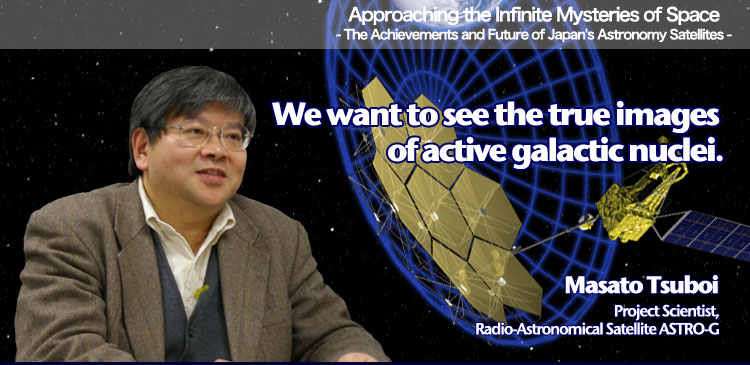

Q. What type of satellite is ASTRO-G?
The ASTRO-G is a satellite equipped with a radio telescope that will be used to collect and acquire radio waves emitted from astronomical objects. Using a technique called Space VLBI (Very Long Baseline Interferometry), ASTRO-G provides unprecedentedly high spatial resolution to observe active galaxies, young stellar objects and other objects in detail.
Space VLBI technology performs astronomical observation by using a radio astronomy satellite in conjunction with many radio telescopes on the ground. The radio astronomy satellite HALCA (Highly Advanced Laboratory for Communications and Astronomy), launched in 1997, demonstrated this method for the first time.
Here's how VLBI works. The larger the diameter of a radio telescope, the higher the resolution. There is a technique called interferometry. It acquires the angular resolution by putting more than two separated telescopes instead of making a radio telescope with the larger diameter. For example, using two telescopes on the ground located 100 km apart, we can get almost the same resolution we would get using an enormous telescope with a diameter (aperture) of 100 km. The distance between telescopes is called the baseline; the longer the baseline, the higher the resolution. VLBI records signals received at each telescope are recorded to tapes or hard disks. The recorded data is collected in one place, and played back using a correlator. Using interferometry, the technique combines these sets of data are played back and correlated using a correlator, and produce a single high-resolution image. By combining on-the-ground telescopes in Japan and all over the world with one in space, ASTRO-G will be a virtual antenna with a diameter of 35,000 km, which is greater than the diameter of the Earth. This virtual antenna will have an angular resolution of 40 micro-arcsecond. Imagine looking from Earth at a ball on the surface of the moon. ASTRO-G will make it possible to distinguish between a softball and a ping-pong ball, providing the highest-ever resolution of any radio astronomy satellite.
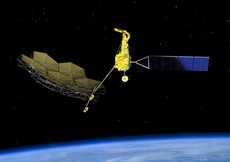
Radio Astronomical Satellite ASTRO-G
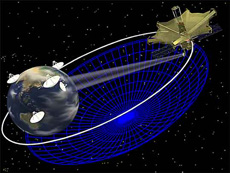
Space VLBI by the radio astronomical satellite HALCA

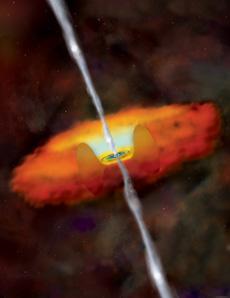
Active galaxy core (Courtesy of Aurore Simonnet, Sonoma State University)
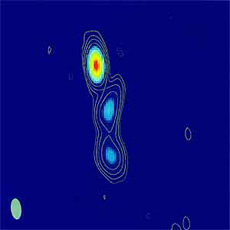
Quasar observed by HALCA using VSOP. The bright part is a galaxy core and the dark part is radio waves coming from the jet.
Q. What will you mainly be observing?
We will be observing active galactic nuclei. Some galaxies exhibit violent activities at the center, which is called active galactic nuclei. A black hole exists at the center of the active galactic nuclei. It has a mass millions of times greater than the sun, but we cannot see it. We know that various phenomena occur around the black hole. For example, erupting from the black hole is a high-energy jet the length of one million light years. How was this jet formed, and how did it accelerate? At the same time, matter in the form of gases and dust spirals down, falling into the black hole and creating a disk-shaped object (called an accretion disk) around it. What is the structure of this accretion disk? ASTRO-G will allow us to study the structure and size of the accretion disk. In fact, we believe that the satellite's ability to capture images of an active galactic nuclei will reveal many of the galactic nuclei's mysteries.
In astronomical objects, there are certain objects that emit a particular kind of strong radio wave, called a maser emission line. These waves are very bright, making it possible to study how a star moves. ASTRO-G will observe the maser emission lines of water vapor in astronomical objects, allowing us to study how stars are formed. In the central core of extragalaxies, there is a very strong maser line called a mega-maser. ASTRO-G will observe extragalactic mega-maser of water vapor, and study the mass, temperature and density of an active galactic nuclei, as well as the mass accretion rate onto a black hole. It will also make highly sensitive measurements of various astronomical phenomena, such as a flare explosion in the magnetosphere at the initial stage of a protostar's birth.
Q. What results did you obtain with the Radio-Astronomical Satellite HALCA, and how will you now build on those results with ASTRO-G?
HALCA is an engineering experimental satellite developed to demonstrate Space VLBI observation technology, which is at the heart of the VLBI Space Observatory Program (VSOP), an international project with several partners. HALCA successfully deployed the huge antenna in space and performed experiments confirming the VLBI interferometry technique. It was the world's first Space VLBI observation satellite.
HALCA's most significant results were two-fold. First, it made images of the jets from active galactic nucleis, revealing the behavior of the magnetic field around a black hole. And it also uncovered evidence of the existence of a plasma disk. However, these results represent only a part of the phenomena, and the phenomena we have not yet understood in detail is still remain. As part of the VSOP-2 project, ASTRO-G will further develop the technologies established with HALCA, and study the more inner parts of the active galactic nuclei. ASTRO-G will observe the structure of the magnetic field at inner most region on the jet from the active galactic nuclei with a resolution 10 times that of HALCA. Because of the magnetic field may significantly relate to the eruption of jets from the active galactic nuclei, the structure of the magnetic field will become a clue to solving the problem of how the jet is formed.